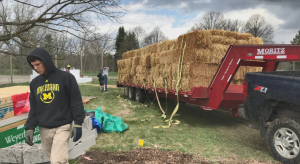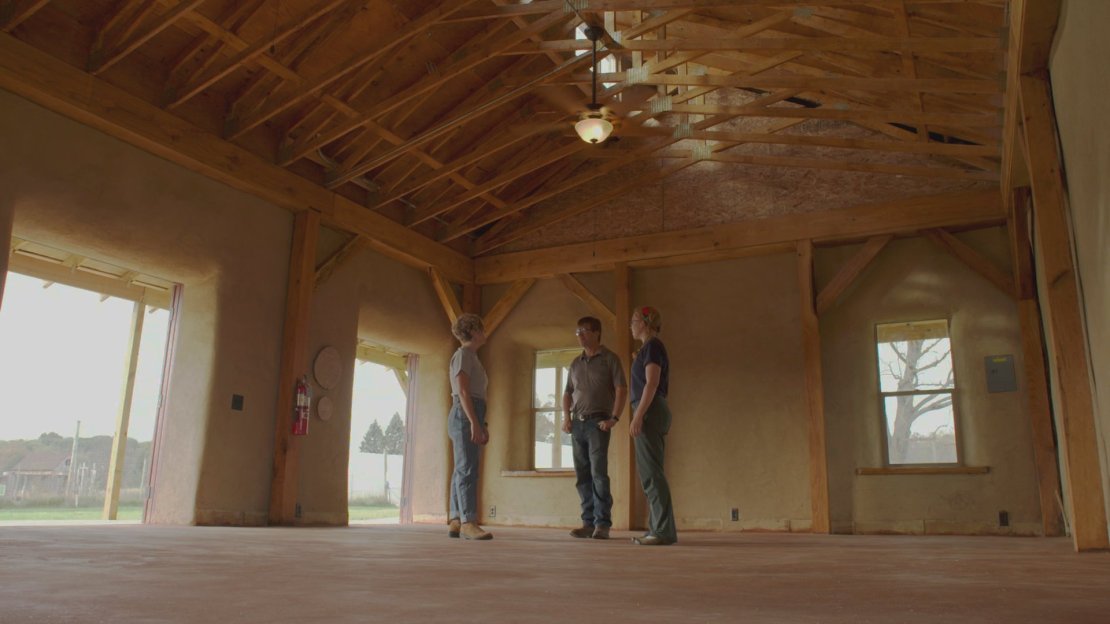John Tolley, March 30, 2019
Do you remember the story of the Three Little Pigs? Do you remember how that first little pig didn?t stand a chance, shaking in his straw shanty, just waiting for that huff and puff? Well, he?d be singing a different tune if he?d met Joe Trumpey.
That?s because Trumpey, an Associate Professor of Art and Natural Resources at the University of Michigan, has built not one, but three sturdy and robust straw bale structures, including his own farmhouse.
?About twenty years ago, I began a research track of figuring out what kinds of buildings could make sense, living in the Midwest,? he explains. ?I eventually decided that straw bale buildings could become a good fit for us. My home is a proof of concept building. We want it to be a place where we could educate others.?
Recently, Trumpey and a group of students put the finishing touches on the first straw bale building on the University of Michigan?s Ann Arbor campus. It was a labor of love and learning for the group, who used a preponderance of recycled materials to build the structure.
?Obviously a straw bale building is made out of straw bales,? says Logan Vear, a junior Environmental Engineering major who helped on the build. ?So, all of the walls are basically just stacked up straw bales. Then they?re compressed down so it gives them some strength and coated in the adobe mixture, so that?s basically just a mixture of mud, clay, sand and some chopped up straw.?
 As Vear further explains, the wood used in the building, which is far less than what would be used in a conventional wood-framed structure, was sourced completely from campus trees that were dead or dying. The straw for the house is a common agricultural by-product, and an extremely efficient insulation.
As Vear further explains, the wood used in the building, which is far less than what would be used in a conventional wood-framed structure, was sourced completely from campus trees that were dead or dying. The straw for the house is a common agricultural by-product, and an extremely efficient insulation.
All of this adds up to a building with a greatly reduced impact on the Earth. ?Homes and buildings represent about ten percent of our carbon footprint. Primarily that?s about heating and cooling and electricity use. Electricity represents about thirty percent of our [total] carbon footprint across North America,? says Trumpey.
Aside from the energy savings, the use of natural materials in the building is also helpful in mitigating environmental contaminants that often come with common building materials, such as cement, solvents and other volatile organic compounds.
?A lot of the materials that are used in conventional buildings are not good for the environment,? says Kristin Hayden, a junior majoring in Earth and Environmental Engineering. ?They pollute water and they pollute the air, and when they break down, they break down to things that poison people and animals. This building uses materials that are less toxic and less damaging and that take less energy to pull out of the ground.?

The recent build, located on the campus farm, follows the example set by Trumpey and another group of students who built the university?s first straw bale structure at the University of Michigan Biological Station in far north Pellston, MI. That structure was a proving ground not just for campus leader?s confidence in such an unusual construction, but for the students? confidence in their own set of skills.
?It?s very empowering for the students and it?s also empowering for me as an educator to have faith in the students that a group with very minimal skills at the beginning of a month can ratchet it up pretty quickly and be productive,? Trumpey remarks. ?At the end of the month, they just literally stand around with smiles on their faces. It?s not unusual to see them laying on the floor looking up at the ceiling and go, wow, look at what we just did.?
That sort of hands-on, experiential learning is exactly what drew Vear to the University of Michigan. Active in a number of different environment and sustainability focused groups on campus, she notes that participating in the straw bale build with Trumpey was a definitive moment in her active learning, one she will not soon forget.
?Bringing my parents here the other week, and talking with my peers as well as faculty members and members of the community, I can point to that and be like, yeah, that happened and we actually built an extremely sustainable structure that will be there for however many years,? she says.

The building will serve a multi-purpose role at the university as an event space for the campus farm and as teaching model for sustainable construction methods. Students, faculty and community members will be able to learn more about the farm and its commitment to sustainable agriculture at farm-to-table dinners planned by UM Dining. The building is also completely off-the-grid, allowing design, engineering and architecture students to ponder the production and consumption of energy and how both can be done more efficiently. Both uses are a testament to the renewed connection we need to have with our planet, Trumpey Notes.
?The overall mission is really about carbon awareness and carbon reduction. U of M is an enormous place, more than 45 thousand students. We have pushing 37 million square feet of buildings on campus. So, the carbon footprint that our community represents is immense. As we?re trying to push towards carbon neutrality, we need more awareness. We need more creativity; we need beautiful things to happen.?







